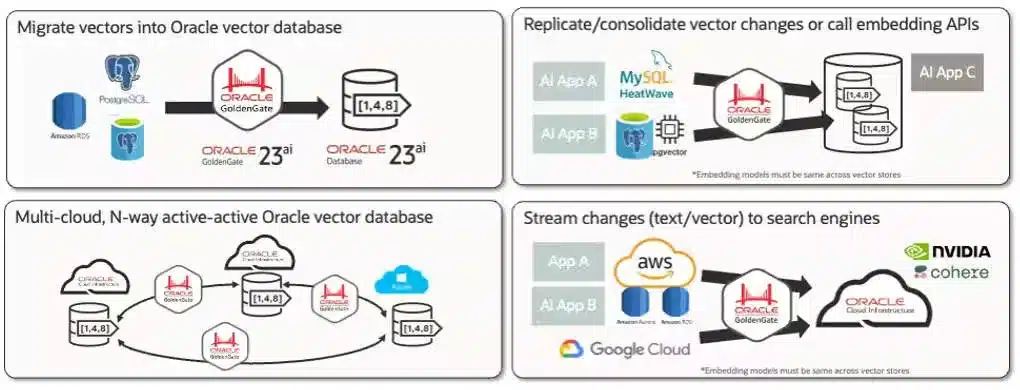Oracle GoldenGate is a real-time data replication solution offered by the American computing giant Oracle. Discover its features, architecture, use cases, and its many benefits for businesses!
Real-time data management is of paramount importance for businesses. It helps maintain smooth operations while ensuring the availability and reliability of information. To address this challenge, Oracle offers a real-time data replication solution providing organizations with all the tools necessary to replicate, migrate, and synchronize data across different systems and platforms without interruption: GoldenGate.
This software ensures continuity of services, even in complex environments, thanks to its ability to capture and replicate changes instantly. It also guarantees high availability, low latency, and multi-platform flexibility. All these advantages make it a strategic ally for optimizing data management infrastructure!
Main features of GoldenGate
The numerous features of Oracle GoldenGate make it a choice for companies wishing to implement real-time data replication. Indeed, this platform enables continuous data replication. This means that transactions made on the source database are immediately applied to the target database.
This ensures a constant synchronization of systems and eliminates delays that could affect data consistency. Furthermore, thanks to CDC (Change Data Capture) technology, Oracle GoldenGate can identify and replicate only the modifications made to the data.
It is therefore not necessary to transfer the entirety of the information at each synchronization. This allows you to significantly reduce network load and improve the overall system performance. Another major asset of GoldenGate is its compatibility with numerous database systems. It supports Oracle Database as well as other databases like MySQL, SQL Server, DB2, PostgreSQL, and even Big Data environments.
This flexibility allows companies to replicate data between different systems while ensuring their integrity. The platform also offers advanced fault tolerance, ensuring that data is always accessible and protected even in cases of interruptions or hardware failures. Thus, critical applications benefit from increased resilience.
All these features make GoldenGate particularly well-suited to the current needs of businesses, especially with its ability to integrate with other Oracle solutions and operate in cloud or hybrid environments…

An Architecture Composed of Multiple Modules
The different components of the GoldenGate architecture are interconnected, allowing for the capture, transfer, and application of data between source and target systems. The capture process begins with the Extract component, which extracts transactions from the source database. It extracts the changed data and stores it in trail files to be processed later.
These files can be compressed and transferred via the Data Pump: an optional component, but often used to transmit trail files to the target database. It helps reduce the risks of data loss during transfer and offers additional protection in case of failure. This allows for improved performance and resilience.
To conclude, the Replicat component applies the captured transactions to the target databases. It reads the trail files and applies them in chronological order to guarantee data consistency between systems and ensure exact replication. Thus, the architecture is as follows:
Source database → Extract → Trail Files → (optional: Data Pump) → Trail Files → Replicat → Target database
Thanks to this data flow, modifications are captured and applied with low latency and high precision. The architecture can also be customized according to the specific needs of the company’s environments!
What is GoldenGate used for in businesses?
This solution is used in many scenarios to meet the needs of data replication and synchronization. It is ideal for complex environments where different databases need to exchange information in real-time.
For example, a company may have an Oracle database for its main application and a MySQL system for its e-commerce. In this case, GoldenGate allows data replication between these systems. It thus ensures a constant synchronization and data consistency between the platforms.
When migrating a database to a new version or a new platform, Oracle’s tool allows for continuous migration without activity downtime. It captures changes made to the source database during the migration and applies them to the new database. This ensures a smooth transition without data loss.
Similarly, in distributed environments where multiple systems and databases operate independently, GoldenGate allows for real-time data reconciliation. Therefore, information from different branches or regions of a company is synchronized efficiently. Decision-making and operational visibility are greatly improved!
Updating development and test environments with real-time data from production systems is also facilitated. This allows developers and test teams to work with recent and relevant data without impacting production systems. Both powerful and versatile, GoldenGate meets the needs of a wide variety of environments and is therefore very useful.

What are the advantages?
For businesses looking to optimize their real-time data management and ensure the availability of their critical systems, Oracle GoldenGate offers a multitude of advantages.
Firstly, it allows for data replication with minimal latency. By capturing changes as they occur and replicating them instantly on the target database, it ensures that data is synchronized in real-time even in high-transaction volume environments. Performance is thus maximized, even in complex architectures. Furthermore, thanks to the possibility of database migration without interruption, this tool significantly reduces the risks of costly downtime.
For companies whose systems must be continuously operational, such as in the finance, e-commerce, or telecommunications sectors, this is a real strength. This solution is also compatible with a wide variety of systems, including non-Oracle databases, Big Data environments, and cloud systems.
Companies can leverage this flexibility to implement hybrid or multicloud architectures while continuing to use existing systems. Moreover, GoldenGate integrates perfectly with other Oracle tools like OCI and Oracle Database. It thus offers the possibility of centralized data management!
Designed to adapt to the needs of growing businesses, this solution is also highly scalable. It can adjust for a small business as well as a gigantic organization with billions of transactions to process. Furthermore, enhanced security features, such as data encryption during transfer, are available to ensure that sensitive information is protected at each step of replication.
Best tips for using GoldenGate
Despite its power, GoldenGate presents challenges that administrators must be aware of to ensure optimal operation. In environments with databases located over great geographical distances, latency issues may arise.
It is necessary to consider network bandwidth and optimize the transmission of trail files to avoid any delay in replication. During bidirectional replication, conflicts can occur when contradictory transactions happen simultaneously on multiple databases. These conflicts must be managed with strict rules to guarantee data integrity.
Another challenge might be to configure GoldenGate for complex or heterogeneous systems. Advanced technical skills are therefore necessary to ensure that the tool is properly deployed and optimized.
However, by following certain best practices, it is possible to overcome these obstacles and fully exploit its potential. Before deploying this tool, it is imperative to carefully analyze the architecture of the source and target systems. Good planning helps prevent conflicts and errors during replication.
Using monitoring tools, like Oracle Enterprise Manager, allows for real-time monitoring of GoldenGate’s performance. It’s an excellent way to identify anomalies, replication delays, or any other issue. To optimize performance and reduce latency, you can compress trail files before transferring them. This is especially useful in environments with high network latency.

Additionally, regular testing ensures that replication is working as intended and that data is consistent between the source and target systems. This helps quickly detect any discrepancies. Nevertheless, the best way to maintain smooth GoldenGate management is to train technical teams!
A powerful data replication tool
Both powerful and flexible, Oracle GoldenGate positions itself as a real-time data replication solution suited to a wide range of industrial needs.
Whether it’s maintaining the high availability of critical systems, managing complex migrations, or synchronizing heterogeneous databases, it provides all the tools necessary to meet these challenges.
To learn how to master GoldenGate, you can choose DataScientest. Our online courses enable you to gain real expertise on the various technologies of the Oracle ecosystem. After completing our practice-focused and hands-on curricula, you will be fully ready to handle GoldenGate within a company and receive an official Oracle certification. All our courses are available in BootCamp, work-study, or continuous formats, and our organization is eligible for funding through CPF or France Travail. Discover DataScientest quickly!










